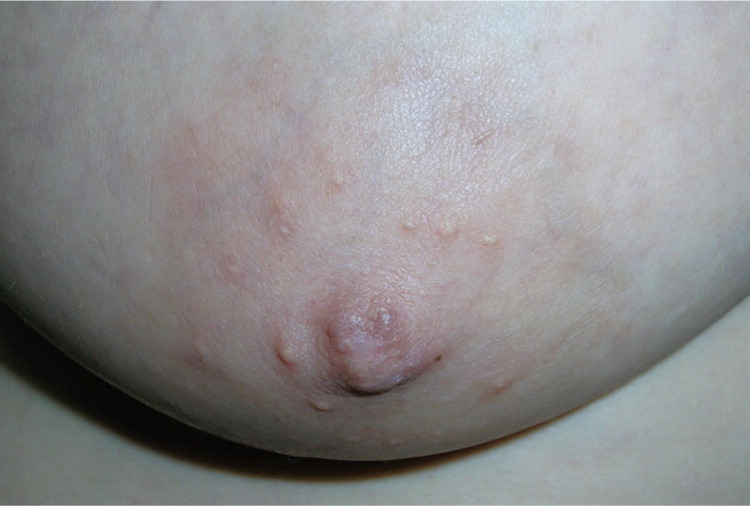
Am Fam Physician. 2016;93(4):297-298
Author disclosure: No relevant financial affiliations.
A 54-year-old woman presented with a non-pruritic rash on her nipple for the past three months. It began as a large plaque covering approximately one-fourth of the breast, but gradually decreased to a small plaque affecting only the nipple. She had occasional spontaneous milky discharge from the nipple. She had normal mammographic findings the previous month and no family history of breast cancer.
Physical examination revealed a small pink plaque with scale on the left nipple. Compared with the unaffected side, there was a noticeable flattened appearance and loss of the normal Montgomery tubercles of the areola (Figures 1 and 2). There were no palpable breast masses or other similar skin plaques.


Question
Discussion
The answer is B: Paget disease. The diagnosis was confirmed with a punch biopsy of the nipple. Computed tomography of the chest showed an enhancing lesion in the upper inner quadrant of the left breast, with abnormal enhancement of the left axillary lymph nodes and innumerable osseous densities consistent with metastatic disease. Paget disease of the breast is a rare type of breast cancer. It presents as an eczematous eruption caused by epidermal migration of malignant cells from an underlying breast carcinoma, most often ductal carcinoma in situ or invasive ductal carcinoma.1–5 Paget disease represents approximately 2% of all cases of breast cancer.1
Clinically, Paget disease of the breast presents as a pink or red, scaly patch or plaque that begins on the nipple and spreads outward to the areola.1–5 Associated symptoms may include nipple discharge, nipple retraction, pruritus, and a breast mass.1–5 In this case, the normal architecture of the nipple was lost. A palpable breast mass is present in only about one-third of patients, and may be located in the nipple areola complex or more peripherally in the breast.1 Paget disease should be considered in any patient with a current or previous eczematous eruption of the nipple.3,4 In one study, 17% of patients diagnosed with Paget disease reported a history of a healed nipple lesion.3 Paget disease of the breast may be misdiagnosed as atopic dermatitis or eczema, and it may resolve with or without topical steroids.2 An important clue to the diagnosis of Paget disease of the breast is that it always involves the nipple.2
Biopsy confirms Paget disease with Paget cells on histology. All patients with biopsy-confirmed Paget disease of the breast should undergo mammography to evaluate for underlying breast carcinoma.2 Mammography may underestimate the extent of the disease and may be normal in 22% to 43% of women with Paget disease of the breast.1,2 Therefore, biopsy is indicated for nipple lesions if Paget disease is clinically suspected, even with normal mammographic findings.2 Breast magnetic resonance imaging may be useful in cases of subtle mammographic findings to further evaluate the extent of disease.2 Prognosis depends on the stage of the disease and tumor characteristics. A 15-year breast cancer–specific survival rate for patients with invasive Paget disease has been reported at 60% to 87%.5
Eczema of the nipple presents as pruritic, erythematous, scaly, lichenified patches or plaques. It is commonly bilateral and extends beyond the areola. It is typically associated with other signs of atopy.4
Papillary adenoma is a benign tumor of the lactiferous duct that presents with unilateral serous or bloody discharge that worsens before menses. Other findings may include a mass within the nipple or nipple inversion, and erythema, crusting, or ulceration of the nipple.4
Psoriasis of the breast is not commonly isolated. It presents as pink plaques with silvery scale and is usually associated with other features of psoriasis, such as psoriatic plaques on extensor surfaces of the elbows and knees. Inframammary psoriasis or inverse psoriasis has a clinical appearance similar to intertrigo.4

| Condition | Characteristics |
|---|---|
| Eczema of the nipple | Pruritic, erythematous, scaly, lichenified patches or plaques; commonly bilateral and extends beyond the areola; typically associated with other signs of atopy |
| Paget disease of the breast | Pink or red, scaly patch or plaque; begins on the nipple and spreads outward to the areola; nipple discharge and retraction, pruritus, breast mass |
| Papillary adenoma | Unilateral serous or bloody discharge that worsens before menses; mass within the nipple or nipple inversion, erythema, crusting, or ulceration of the nipple |
| Psoriasis of the breast | Pink psoriatic plaques with silvery scale; usually associated with psoriatic plaques on the elbows and knees |

